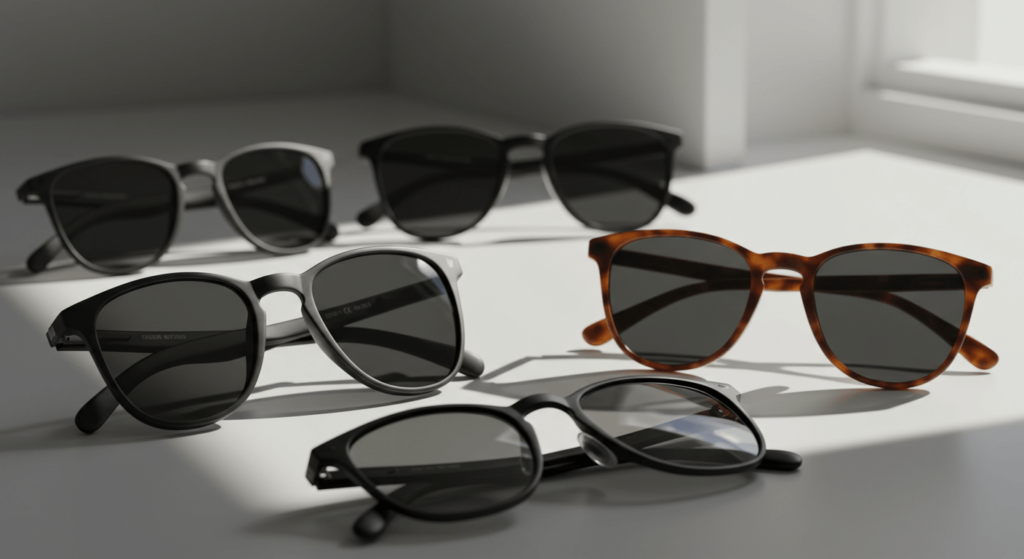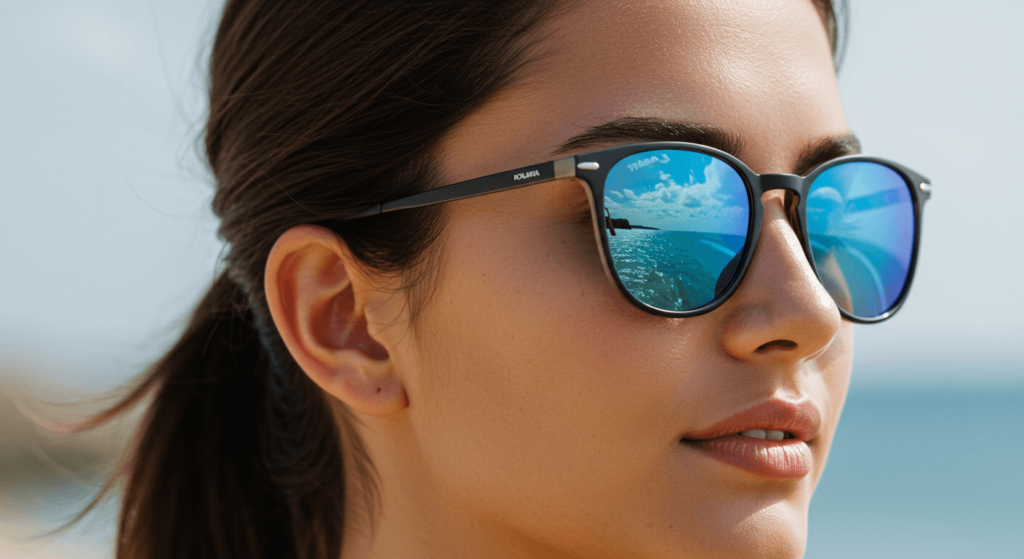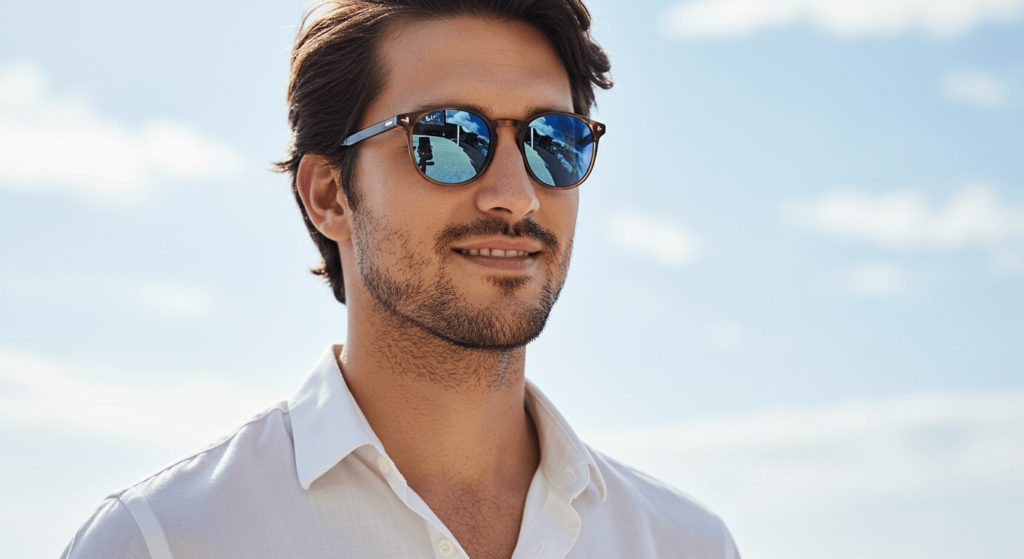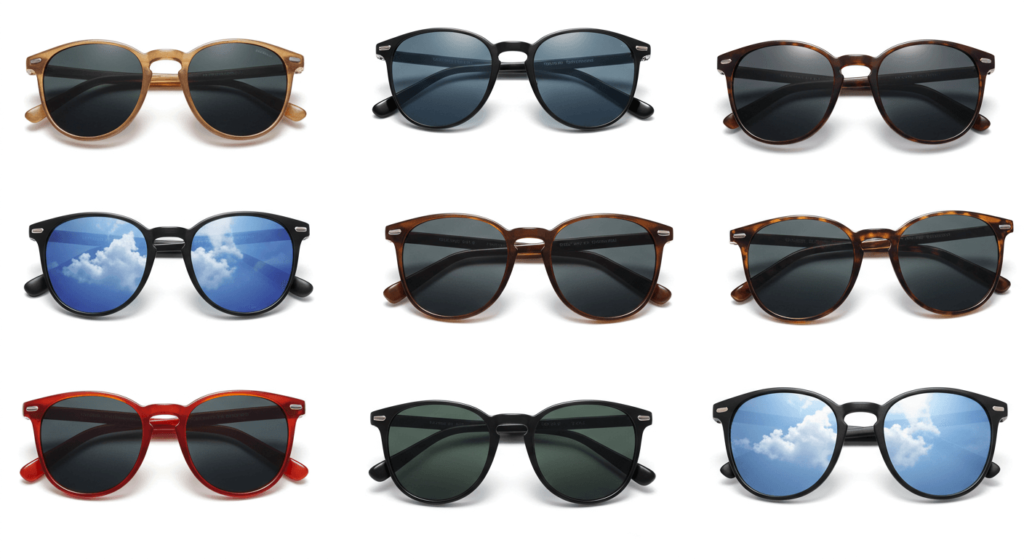The Best Polarized Sunglasses for Your Needs: Why Sunglasses Are Essential for Sun Protection (Beyond Fashion!)
Did you know that prolonged exposure to UV radiation can increase your risk of developing cataracts by up to 60%? While most people associate sun protection with skin care, your eyes deserve equal—if not more—attention. The delicate tissues in your eyes are extremely vulnerable to the sun’s harmful rays, making proper protection not just a recommendation but a necessity for long-term eye health.
Polarized sunglasses stand at the forefront of eye protection technology, offering benefits that extend far beyond making a fashion statement. Unlike regular sunglasses, polarized lenses employ specialized technology that filters light in ways that dramatically reduce glare and protect your eyes from harmful UV radiation.
In today’s world where outdoor activities and screen time have increased, finding the best polarized sunglasses for your specific needs has never been more important. Whether you’re a water sports enthusiast, an avid driver, or simply someone who spends time outdoors, understanding how polarized sunglasses work and which ones best suit your lifestyle can make a significant difference in both your comfort and long-term eye health.
This comprehensive guide will walk you through everything you need to know about polarized sunglasses—from how they work and their benefits to choosing the best options for different activities and face shapes. By the end, you’ll be equipped with the knowledge to make an informed decision about investing in the right pair of polarized sunglasses for your needs.
What Are Polarized Sunglasses and How Do They Work?
The Science Behind Polarization
Polarized sunglasses utilize a unique technology that fundamentally differs from standard tinted lenses. To understand how polarized lenses work, we first need to understand how light behaves. Natural light waves vibrate in all directions, but when light reflects off flat surfaces like water, snow, or roads, it becomes “polarized,” meaning the light waves align horizontally. This horizontal alignment creates intense glare that can impair vision and cause eye strain.
Polarized sunglasses contain a special chemical filter that is applied to the lens in a vertical pattern. This vertical polarization allows only vertical light to pass through while blocking most of the horizontal light waves—effectively eliminating glare from reflective surfaces. The result is clearer vision with enhanced contrast and less eye fatigue.

Visual Comparison: Polarized vs. Non-Polarized
The difference between viewing the world through polarized versus non-polarized lenses is striking, especially in high-glare environments:
| Scenario | With Regular Sunglasses | With Polarized Sunglasses |
|---|---|---|
| Driving on a sunny day | Reduced brightness but persistent glare from road and other vehicles | Significantly reduced glare, clearer vision of road and surroundings |
| Water activities | Difficulty seeing below water surface due to reflections | Increased ability to see beneath water surface |
| Snow sports | White-out effect, difficulty distinguishing terrain features | Enhanced contrast, better depth perception |
| Urban environments | Reflections from buildings and cars create visual noise | Sharper details, reduced eye strain |
The Evolution of Polarized Lens Technology
Polarized lens technology has come a long way since its invention in 1929 by Edwin H. Land (who later founded Polaroid). Today’s best polarized sunglasses incorporate multiple layers of technology:
- Base layer – Usually made of polycarbonate, CR-39, or glass
- Polarizing filter – The chemical film that blocks horizontal light waves
- UV protective coating – Blocks harmful UVA and UVB rays
- Anti-reflective coating – Reduces internal reflections within the lens
- Scratch-resistant layer – Protects the lens from everyday wear and tear
- Hydrophobic/oleophobic coatings – Repels water and oil for easier cleaning
Understanding this technology helps explain why quality polarized sunglasses often command higher prices than their non-polarized counterparts—they’re not just tinted plastic, but sophisticated optical devices designed to protect your eyes and enhance your visual experience.

The Hidden Dangers of Sun Exposure to Your Eyes
Many people are diligent about applying sunscreen to protect their skin but overlook the equally important need to shield their eyes from the sun’s harmful effects. The consequences of unprotected eye exposure to UV radiation can range from temporary discomfort to permanent vision loss.
Understanding UV Radiation Types
The sun emits three types of ultraviolet radiation:
- UVA rays – Penetrate deep into the eye and can cause long-term damage to the retina
- UVB rays – Primarily absorbed by the cornea and lens, contributing to cataract formation
- UVC rays – Mostly blocked by the Earth’s atmosphere (not a significant concern for eye health)
While regular sunglasses might block some light, quality polarized sunglasses provide comprehensive protection against both UVA and UVB rays, making them essential for complete eye safety.
Short-Term Effects of Sun Exposure
Immediate consequences of unprotected sun exposure to the eyes include:
- Photokeratitis – Often called “sunburn of the eye,” this painful condition results from intense UV exposure and can cause redness, tearing, light sensitivity, and temporary vision impairment
- Eye strain and fatigue – Squinting in bright conditions forces eye muscles to work harder
- Headaches – Often develop as a result of prolonged squinting and eye strain
- Temporary vision disturbances – Spots, halos, or blurred vision after exposure to intense light
Case Study: Summer Festival Attendees In a 2023 study at a multi-day outdoor music festival, researchers found that 68% of attendees who didn’t wear protective eyewear reported symptoms of photokeratitis by the end of the event, compared to just 7% of those who consistently wore polarized sunglasses with UV protection.
Long-Term Eye Damage from Sun Exposure
The cumulative effects of years of unprotected sun exposure can lead to serious, sight-threatening conditions:
- Cataracts – The clouding of the eye’s natural lens, leading to blurry vision and, eventually, possible blindness if untreated
- Macular Degeneration – Deterioration of the central portion of the retina, leading to loss of central vision
- Pterygium – A growth on the conjunctiva that can extend to the cornea, causing irritation and affecting vision
- Skin Cancer – The delicate skin around the eyes is particularly vulnerable to developing skin cancers
- Premature Aging – Sun exposure contributes to wrinkles and discoloration around the eye area
Activity-Specific Risks
Different environments and activities present varying levels of UV exposure risk:
| Activity | Risk Level | Why Polarized Protection Matters |
|---|---|---|
| Water Sports | Very High | Water reflects up to 100% of UV rays; polarized lenses reduce glare and protect from doubled exposure |
| Snow Sports | Extreme | Snow reflects up to 80% of UV rays; risk increases 4-5% with every 1,000 feet of elevation |
| Driving | High | Road surfaces create significant glare; UV penetrates car windows |
| Beach Activities | Very High | Combination of direct sunlight and reflection from sand and water |
| High Altitude Activities | Extreme | UV radiation increases 4-5% for every 1,000 ft elevation gain |
Investing in the best polarized sunglasses for your specific activities isn’t just about comfort—it’s about protecting your eyes from these significant health risks.
Key Benefits of Using Polarized Sunglasses
The advantages of choosing polarized sunglasses extend far beyond basic sun protection, offering functional benefits that enhance both visual comfort and performance across various activities.
Superior Glare Reduction
The most distinctive advantage of polarized sunglasses is their unmatched ability to eliminate glare. Unlike regular tinted lenses that merely darken your view, polarized lenses selectively filter light to target the most problematic reflections:
- Water glare reduction: Fishermen have long favored polarized lenses because they can see beneath the water’s surface, helping spot fish and underwater structures that would otherwise be obscured by surface reflections.
- Road safety enhancement: When driving, polarized lenses eliminate the blinding glare from wet roads, car hoods, and other vehicles, significantly improving reaction time and reducing eye fatigue during long drives.
- Snow blindness prevention: In winter environments, polarized lenses cut through the intense white glare that can lead to temporary “snow blindness.”
Enhanced Visual Clarity and Contrast
Quality polarized sunglasses don’t just block light—they optimize what you see:
- Improved color perception: By reducing scattered light, polarized lenses allow you to see colors more vividly and naturally.
- Enhanced detail recognition: The elimination of glare means you can distinguish details that might otherwise be washed out.
- Better depth perception: With reduced visual noise, your brain can better process spatial relationships and distances.
This enhanced clarity isn’t just a comfort feature—for activities like driving, cycling, or skiing, it can be a critical safety advantage.

Prevention of Eye Strain and Fatigue
Our eyes weren’t designed for the constant bombardment of reflected light in modern environments. Polarized lenses help reduce the workload on your visual system:
- Reduced squinting: Less glare means less need to squint, which can lead to tension headaches and facial muscle fatigue
- Lower light sensitivity: Polarized lenses help manage photophobia (light sensitivity) more effectively than regular sunglasses
- Extended comfort during outdoor activities: Whether you’re spending a day fishing or driving across the country, polarized protection means your eyes stay comfortable longer
Comprehensive UV Protection
While not all polarized lenses automatically include UV protection (always check for “100% UV protection” or “UV400” designation), most quality polarized sunglasses incorporate this essential feature:
“Many patients don’t realize that UV damage to the eyes is cumulative and irreversible. Quality polarized sunglasses with UV400 protection are one of the best investments you can make in your long-term eye health.” – Dr. James Wilson, Optometric Association
Special Populations Who Benefit Most
Some groups stand to gain even more from polarized protection:
- Post-cataract surgery patients: Extra sensitivity to light makes polarized protection particularly valuable
- Migraine sufferers: Light sensitivity often triggers or worsens migraines
- People with light-colored eyes: Blue, green, or hazel eyes typically have less pigment and therefore less natural UV protection
- Contact lens wearers: Even UV-blocking contact lenses don’t cover the entire eye, leaving surrounding tissue vulnerable
For these populations, investing in the best polarized sunglasses isn’t just about comfort—it’s about addressing specific visual needs and vulnerabilities.
How to Identify High-Quality Polarized Sunglasses
With countless options claiming to be “polarized,” knowing how to distinguish genuinely protective eyewear from inferior products is essential. Here’s how to identify truly high-quality polarized sunglasses that will protect your eyes effectively.
UV Protection Standards
The most important feature of any sunglasses—polarized or not—is their UV protection capability:
- Look for “UV400” or “100% UV protection”: This indicates the lenses block 99-100% of both UVA and UVB rays.
- CE marking: In Europe, this certification ensures the sunglasses meet basic safety standards.
- ANSI Z80.3: This American National Standards Institute certification indicates the sunglasses meet impact resistance standards.
Important: UV protection and polarization are not the same thing. Some polarized lenses lack adequate UV protection, while many non-polarized lenses offer excellent UV blocking. The best polarized sunglasses combine both features.
Simple Tests to Verify Polarization
Before purchasing or to check sunglasses you already own, try these simple polarization tests:
- The LCD screen test: Look at an LCD screen (phone, calculator, etc.) through the lenses while rotating the glasses 90 degrees. If they’re truly polarized, the screen will appear to darken or become black at certain angles.
- The reflection test: Look at a reflective surface like water or a glossy tabletop. Put on the sunglasses and tilt your head 90 degrees. If the glare reduction changes significantly as you tilt your head, the lenses are polarized.
- The two-pair test: If you have access to two pairs of supposedly polarized sunglasses, hold one lens over the other and rotate one pair 90 degrees. If both are genuinely polarized, the overlapping area will turn nearly black at certain angles.

Frame Quality Indicators
While the lenses provide the functional benefits, frame quality determines durability and comfort:
- Material quality: Premium frames use materials like acetate, titanium, or high-grade stainless steel rather than basic plastic
- Hinge construction: Look for integrated metal hinges, preferably with multiple barrel designs
- Weight balance: High-quality frames feel substantial without being heavy and balance evenly on your face
- Finish consistency: Check for even coloring, smooth edges, and consistent texture
Lens Material Differences
The material of your polarized lenses affects durability, clarity, and weight:
| Lens Material | Pros | Cons | Best For |
|---|---|---|---|
| Glass | Superior optical clarity, Very scratch-resistant | Heavier, Can shatter, More expensive | Fishing, Photography, Premium eyewear |
| Polycarbonate | Extremely impact-resistant, Lightweight, Good UV protection | More prone to scratches, Slightly less optical clarity | Sports, Active lifestyles, Children |
| CR-39 (Plastic) | Excellent optical clarity, Lightweight, Less expensive | Less impact-resistant, Moderately scratch-prone | Everyday wear, Budget-conscious buyers |
| Trivex | Impact-resistant, Lightweight, Better optical quality than polycarbonate | More expensive than polycarbonate | Active lifestyles requiring optical precision |
Price as a Quality Indicator
While price doesn’t always correlate perfectly with quality, extremely cheap “polarized” sunglasses often cut corners in ways that compromise protection:
- Under $20: Typically use basic polarizing films that can delaminate quickly and may lack complete UV protection
- $20-$60: May offer adequate protection but often sacrifice durability and optical clarity
- $60-$150: The sweet spot for many quality polarized options with good protection and durability
- $150+: Premium materials, construction, and often specialized features for specific activities
“With polarized sunglasses, you generally get what you pay for. The difference between $30 gas station sunglasses and quality $100+ polarized sunglasses is substantial—not just in style, but in actual protection and visual performance.” – Lisa Chen, Optical Industry Analyst
Remember that the best polarized sunglasses for your needs balance protection, comfort, durability, and visual performance—all factors that quality manufacturing tends to address better than budget options.
Premium Options with Exceptional Quality
These top-tier brands command higher prices but deliver superior materials, craftsmanship, and often lifetime warranties:
- Known for: Proprietary PolarizedPlus2® lens technology with exceptional color enhancement
- Strengths: Unmatched color vibrancy, extensive lens color options, excellent glare reduction
- Best for: Water activities, color-critical environments, those willing to invest in superior optics
- Price range: $279.00 $139.50 per in($139.50$139.50 / in)
- Known for: Marine-specific polarized technology, extremely durable construction
- Strengths: Superior polarization for water environments, rugged build quality, specialized lens tints
- Best for: Serious anglers, boaters, and water sports enthusiasts
- Price range: $209.00
- Known for: Handcrafted Italian heritage, distinctive design elements
- Strengths: Exceptional build quality, classic styling, premium materials
- Best for: Fashion-conscious buyers seeking heritage quality and timeless design
- Price range : $279.00
For those seeking high-quality polarized sunglasses without the premium price tag, here are some affordable options that combine style, functionality, and value:
Goodr OGs Polarized Sunglasses
These budget-friendly sunglasses offer glare-reducing lenses that block 100% of harmful UVA and UVB rays. Designed with a lightweight, no-bounce fit and a grip-coated frame to prevent slippage during activities, they are ideal for sports and outdoor adventures.
Knockaround Fast Lanes Polarized Sunglasses
Featuring polarized lenses that block glare from reflective surfaces and provide UVA and UVB protection, these sunglasses are praised for their comfortable fit and stylish design. They offer significant value at an accessible price point.
Sojos Polarized Sunglasses
Favored by celebrities and available in various styles, including oversized square and classic aviator designs, Sojos sunglasses are lightweight, comfortable, and start at just $19. They have received positive customer reviews for quality and affordability
Top Features to Consider When Choosing Polarized Sunglasses
Selecting the best polarized sunglasses involves evaluating various features beyond just polarization. Understanding these elements will help you make a choice that perfectly suits your lifestyle, activities, and personal preferences.
Lens Color Options and Their Applications
Different lens colors filter light in distinct ways, making certain tints better suited for specific environments:
- Gray lenses – Reduce brightness without altering colors; ideal for general use and driving
- Brown/Amber lenses – Enhance contrast and depth perception; excellent for variable conditions, fishing, and golf
- Green lenses – Provide good contrast with minimal color distortion; great for general outdoor activities
- Yellow/Orange lenses – Dramatically increase contrast in low-light conditions; useful for dawn/dusk activities, but not ideal for bright sunlight
- Blue/Purple lenses – Fashion-oriented but can help reduce eye strain from yellow light; less practical for intense outdoor activities
Pro tip: For versatility, gray polarized lenses work well in most conditions, while brown polarized lenses excel in environments where contrast perception is important.
Frame Styles and Face Shape Compatibility
The right frame complements your face shape while providing proper coverage:
| Face Shape | Recommended Frame Styles | Styles to Avoid |
|---|---|---|
| Round | Square, rectangular, angular frames | Round, small frames |
| Square | Round, oval, curved frames | Angular, geometric frames |
| Oval | Most styles work well | Extremely oversized frames |
| Heart | Bottom-heavy frames, aviators | Heavy top-bar styles |
| Diamond | Oval frames, rimless styles | Narrow frames |
| Triangular | Top-heavy frames, decorative top details | Bottom-heavy frames |
Beyond aesthetics, frame style affects functionality:
- Wrap-around frames provide additional side protection from peripheral light
- Semi-rimless styles often offer better downward visibility
- Full-rim frames typically offer the most durability and lens stability
Durability Factors
For polarized sunglasses that will withstand daily use and active lifestyles, consider these durability features:
- Frame materials: Titanium and high-quality acetate offer the best combination of flexibility and strength
- Lens coatings: Look for scratch-resistant coatings, especially on polycarbonate lenses
- Hinge quality: Spring hinges provide flexibility and reduce breakage risk
- Manufacturing standards: Sunglasses meeting ANSI Z80.3 impact standards offer better durability
- Lens attachment method: Full-rim frames provide better lens security than rimless or semi-rimless options

Comfort Features Worth Investing In
Even the best polarized sunglasses won’t protect your eyes if they’re too uncomfortable to wear consistently:
- Adjustable nose pads – Allow customization for different nose bridges and prevent sliding
- Temple design – Look for temples (arms) that don’t create pressure points behind the ears
- Weight distribution – Well-designed frames distribute weight evenly rather than concentrating it on the nose
- Rubber components – Silicone or rubber nose pads and temple tips improve grip during activity
- Bridge fit – Should match your nose width for optimal comfort and proper positioning
Special Coatings and Treatments
Modern polarized sunglasses often incorporate additional technologies to enhance performance:
- Anti-reflective (AR) coating – Reduces internal reflections within the lens itself
- Hydrophobic coating – Repels water, making lenses easier to clean and improving vision in rainy conditions
- Oleophobic coating – Prevents fingerprint smudges and makes cleaning easier
- Photochromic treatment – Lenses darken or lighten based on UV exposure (note that most photochromic lenses don’t darken well inside vehicles)
- Mirror coating – Reduces glare even further and decreases light transmission for very bright conditions
“The right lens coatings can extend the life of your polarized sunglasses by years while improving their performance in challenging conditions. They’re worth the investment.” – Taylor Martinez, Professional Mountain Guide
By carefully evaluating these features based on your specific needs, you can find the best polarized sunglasses that provide optimal protection, comfort, and performance for your lifestyle.
Best Polarized Sunglasses for Different Activities
Different environments and activities create unique visual challenges that can be addressed with specialized polarized sunglasses. Understanding these activity-specific needs will help you choose the ideal eyewear for your favorite pursuits.
Water Sports and Fishing
Water environments create intense glare and reflected UV radiation, making quality polarization essential:
Key features for water activities:
- Higher light transmission (VLT 15-30%) – Allows you to see into the water while maintaining protection
- Blue-blocking amber/copper/brown lenses – Enhance contrast against blue/green water backgrounds
- Floating frames – Prevent loss if they fall into water
- Extra wrap-around coverage – Blocks light from peripheral angles
- Water-repellent coatings – Shed water droplets for clearer vision
Best polarized sunglasses styles for water sports:
- Full-frame wraparound designs with rubber nose grips
- Models with side shields for complete protection
- Frames with strap attachments for aggressive water sports
Driving and Road Trips
Drivers face unique challenges from road glare, changing light conditions, and the need for clear peripheral vision:
- Gray or copper polarized lenses – Provide true color recognition for traffic lights and signals
- Medium light transmission (VLT 12-18%) – Dark enough for protection but not too dark for dashboard visibility
- Anti-reflective coating – Reduces dashboard reflections on the inside lens surface
- Semi-wraparound styles – Offer side protection without limiting peripheral awareness
- Gradient tinting – Option for long-distance driving (darker on top, lighter on bottom)
Case Study: Highway Safety Research A 2022 transportation safety study found that drivers wearing quality polarized sunglasses had 27% faster reaction times to road hazards in bright conditions compared to those wearing non-polarized sunglasses, and 35% faster than those wearing no sunglasses at all.
Hiking and Mountaineering
Mountain environments present extreme UV exposure due to altitude and varying terrain:
- High altitude-appropriate VLT (8-15%) – Darker lenses for intense high-altitude sunlight
- Brown/copper/rose lenses – Enhance terrain features and improve depth perception
- Side shields (removable ideal) – Block peripheral light that intensifies at altitude
- Durable, lightweight frames – Comfortable for all-day wear
- Spring hinges – Accommodate wearing with hats and headwear
Best polarized sunglasses for mountaineering:
- Technical wraparound designs with removable side shields
- Models featuring ventilation to prevent fogging
- Impact-resistant polycarbonate lenses that won’t shatter at high altitudes
Snow Sports and High-Altitude Activities
Snow reflects up to 80% of UV radiation, creating potential for “snow blindness” and extreme glare:
| Feature | Benefit for Snow Sports |
|---|---|
| Very dark lenses (VLT 5-10%) | Manage intense light from direct sun plus snow reflection |
| Bronze/copper/yellow tints | Enhance contrast in flat light conditions |
| Mirror coating | Further reduces glare and brightness |
| Larger frame coverage | Protects from reflected UV coming from below |
| Foam gaskets or side shields | Block peripheral wind and reflected light |
Everyday Urban Use
For daily wear in city environments, look for polarized sunglasses that balance protection with style and versatility:
- Medium tint (VLT 15-20%) – Works across various urban lighting conditions
- Neutral gray lenses – Provide true color perception
- Classic frame styles – Offer timeless appeal with good coverage
- Scratch-resistant coatings – Stand up to the rigors of daily use
- Lightweight materials – Comfortable for all-day wear
“The best polarized sunglasses for everyday use combine protection with wearability. You want something that protects your eyes but doesn’t feel like you’re wearing specialized equipment.” – Emma Rodriguez, Fashion Editor & Style Consultant
By matching your polarized sunglasses to your most frequent activities, you ensure optimal visual performance and protection in the environments where you need it most. Remember that serious enthusiasts often benefit from owning multiple pairs of activity-specific sunglasses rather than trying to find one pair that does everything.
Popular Polarized Sunglasses Brands Worth Considering
The market offers numerous brands of polarized sunglasses across various price points and specialties. Understanding the strengths of different manufacturers can help you narrow down the options when searching for the best polarized sunglasses for your needs.


